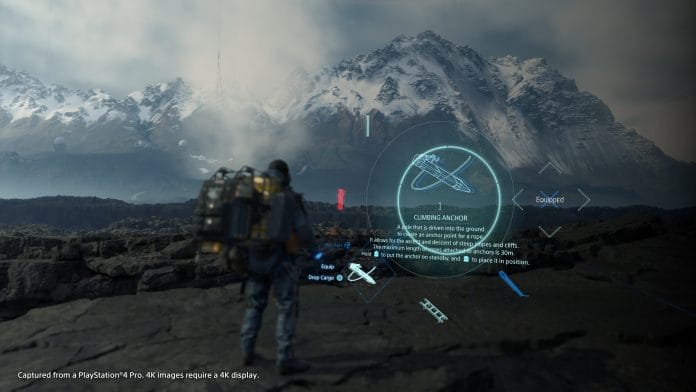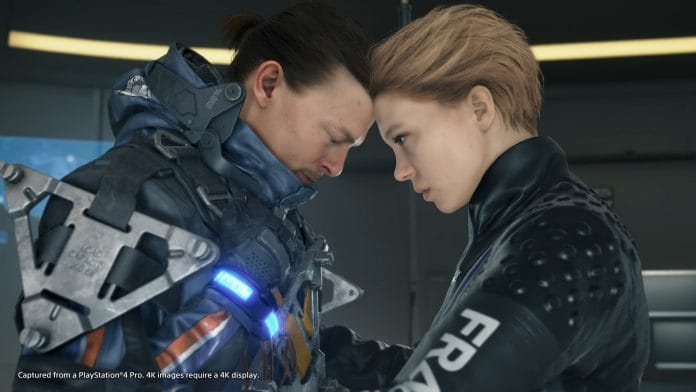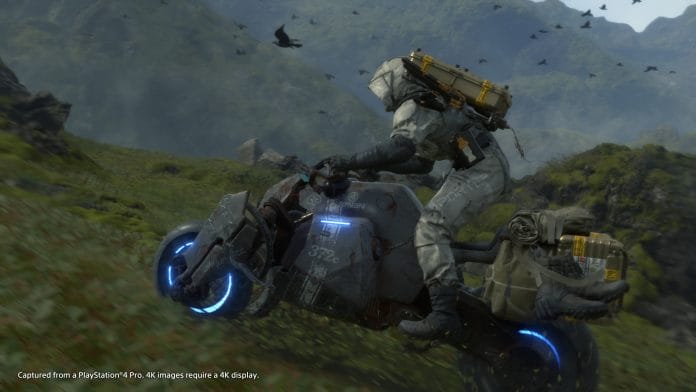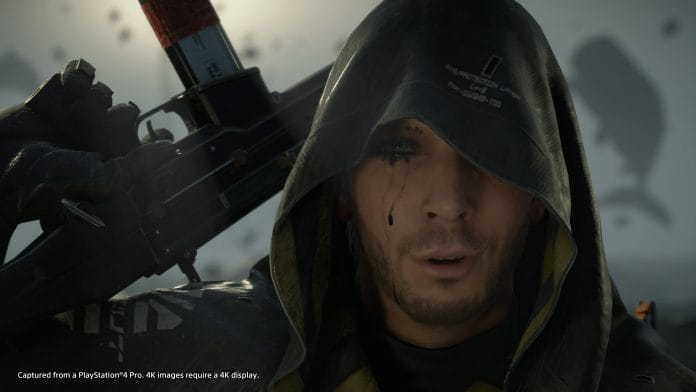On watching Death Stranding’s credits roll at the end of a generous 50-hour campaign a sense of relief washed over me. After the narrative missteps that were Metal Gear Solid 5: Ground Zeroes and The Phantom Pain, Hideo Kojima and his team at Kojima Productions has finally found the right balance of story and gameplay along with spectacular production values that command your time and attention. Death Stranding is a remarkable achievement in ways more than one.
Death Stranding is set in a bleak world fractured by invasions from near invisible otherwordly spirits known as BTs (Beached Things). Global communications have been severed and humanity has been scattered and divided, holed up in underground living quarters. There’s also time fall to contend with — rain that speeds up the ageing process of everything it touches from plants to living beings.
Amidst this chaos, Death Stranding puts you in the role of Sam Porter Bridges. You’re tasked with reconnecting America by visiting key locales across a sprawling map and connecting them to a centralised network. Along the way you’ll contend with rough terrain, terrorists, rogue couriers, and of course BTs.
If Sam’s objective seems a tad too abstract, think of him as an ISP (Internet service provider) employee who pulled the short straw and has to go from door to door connecting an entire neighbourhood to the Internet. Except with the added responsibility of delivering their parcels and fending off monsters, thugs, and the odd terrorist or five in addition to fatal rain, snowstorms, and other environmental hazards— because each house in this neighbourhood is miles apart.

With a premise that has you trekking through vast swathes of terrain, Death Stranding’s traversal feels just right. Walking, running, climbing, and crouching are each easy to perform as is gripping onto surfaces by pressing the DualShock 4’s triggers. Combat is managed with an equally deft touch, allowing you to move from using your fists to a rocket launcher with as few button taps as possible.
The lack of friction in movement and combat is necessary when you consider some of Death Stranding’s other gameplay systems. You’ll manage minute details like where you want to place packages on Sam’s body or if you want to hold them all while paying close attention to how fragile they are as well as the condition they need to be delivered in.
This is crucial because the regions you’ll be passing through are far from hospitable, fraught with BTs and timefall, both of which do vast amounts of damage to your deliveries and you.
Along with this, you’ll also want to ensure that your Bridge Baby or BB for short is in top working condition. BB has been a mascot of sorts for the game since its first reveal and plays an important role, allowing Sam to sense BTs in his vicinity. Falling down, routinely attacked by BTs, or spending too much time in water disturbs BB and doing any of these too often could result in it going into a shock rendering it inoperable.

This makes every step through the world of Death Stranding a lot more dangerous as you have no hint or visibility of BTs outside of the excellent audio cues that suggest your demise is near. Though you can prevent this by soothing BB when you stumble, much like the baby mini-game in the early sections of Yakuza 6.
There’s a certain ebb and flow to the proceedings. One moment you’re running through the hills without a care in the world complete with some excellent music from Low Roar that simply accentuates the mood until you see a rainbow which indicates a BT is near.
The music is replaced by the sound of footprints and the rain as you arm yourself with a grenade to lob the moment you can make out the outline of the invading BT. While you can avoid them completely, actually making contact with one results in the floor turning to tar and you fighting an inky black creature. These encounters are tense and some of them serve as boss fights in Death Stranding. You’ll not only have to be aware of your surroundings but your ammo supply, health, and even endurance as well as their attack patterns making for an exhilarating change of pace. Defeating BTs grants chiralium, a resource used to build structures in the game.
And build you shall. Be it ziplines, generators, the aforementioned grenades or simply ladders, Death Stranding has you fabricating gear aplenty to complete main and side missions. Building consumes materials like metals and resins. Thankfully you’re never quite far from obtaining what you need and it never feels tiresome to do.

All of these elements come together to create an experience that’s greater than the sum of their parts. On their own, Death Stranding’s mechanics are intricate and polished. Together they result in a gameplay loop that’s enjoyable and surprisingly addictive when combined with the story on offer. It may start slow and some may find its opening hours a turn off what with rote package delivery, but its narrative picks up at just the right moments to keep you going and the outcome makes it worthwhile.
Without spoiling much, Death Stranding’s plot is remarkably well-paced. It sports cut-scenes aplenty but they’re expertly directed and edited. They don’t run for too long and neither do they skimp on important details. In fact I found myself looking forward to them due to how much depth they added to the world, its characters, and their motivations.
From seemingly never-ending cut-scenes in Metal Gear Solid 4: Guns of the Patriots to important information hidden away in audio logs in Metal Gear Solid 5: The Phantom Pain, it’s great to see Kojima exercise a sense of cohesion and brevity that was missing in the past. Death Stranding makes sense and its story is expertly crafted and told.
It helps that its backed up by stellar performances throughout. Be it the Guillermo Del Toro-inspired Deadman (voiced by Jesse Corti) or Lea Seydoux as Fragile, a Mary Poppins-like rival courier they’re a memorable bunch that makes Death Stranding more than endearing than it should be.

While all of this makes for a terrific game, there’s an online element to it as well. Rather than have you disarm nukes or tend to a base in the event it gets invaded by other players, the world of Death Stranding becomes a lot more hospitable when you go online. Taking a cue from Dark Souls, you can leave messages. It expands on FromSoftware’s classic by allowing you to create structures like bridges and safe houses for other players to use. It’s a welcome addition that adds to the number of resources at your disposal all while making for a toxic-free online experience.
However Death Stranding isn’t without its shortcomings. For one, the garish Monster Energy cans and ads for The Walking Dead feel out of place in a world that’s portrayed to be one that’s hopelessly lost. Unless of course it’s meant to imply that TV shows past their expiry date and energy drinks would endure an apocalyptic scenario. Either way, their presence breaks immersion. As do the minor but noticeable frame drops when you’re in an area with plenty of weather effects like snow coupled with the PS4 Pro sounding like a jet engine. There’s no option to choose a higher frame rate over better visuals either which further compounds the problem, though Death Stranding never did get to a point where it was unplayable.

The other issues has more to do with how big budget games are portrayed and user expectations. While the more than generous slice of gameplay from TGS 2019 is an accurate glimpse of what you’ll be doing in the game, Death Stranding doesn’t have some of the niceties you’d expect from modern titles.
Fast travel for instance, has you leaving all your equipment behind at the location you fast travelled from rather than have it tag along with you as opposed to games where fast travel incorporates your items too. This also includes mission critical deliveries, forcing you to return to where you teleported from. Early on you’ll spot trucks aplenty but for some reason, they’re all locked and you can’t drive them. Perhaps these oddities are a result of a game designed to compel players to explore its map rather than tick off quests efficiently.
Nonetheless these quirks do little to impact our overall experience with Death Stranding. The superlative story, great cast, and slick gameplay make it well worth playing thanks to being arranged in a cohesive, coherent manner that’s enjoyable from start to finish. Death Stranding is Hideo Kojima’s greatest game yet.




